Burnley, Lancashire
Up to 1834
Burnley's earliest workhouse is said to have been located in the Brennand Street area and was operating by the 1730s.
In 1777, a parliamentary report recorded parish workhouses in operation in Colne (for up to 17 inmates), Barrowford (14), and Burnley with Habergham (50).
In 1819, Burnley erected a new workhouse on Royle Road. The following year, Colne also opened a new workhouse. It was located at Flass, about two miles to the east of Colne. The workhouse burnt down in 1822 but was apparently rebuilt on the same site.
Barrowford's workhouse was located on The Square and consisted of several cottages — the number varied over the years.
Other early workhouses in the area included one adjacent to the Baptist chapel on Nelson Road, Haggate, run by the parish of Briercliffe, and others at Old Laund and Marsden.
In 1832, a workhouse was erected on Blackburn Road, Padiham, to serve the townships of Padiham, Altham, Read and Simonstone. It could house 108 inmates.
After 1834
The Burnley Poor Law Union formally came into being on 20th January 1837. Its operation was overseen by an elected Board of Guardians, 33 in number, representing its 26 constituent parishes and townships as listed below (figures in brackets indicate numbers of Guardians if more than one):
County of Lancaster: Altham, Barley with Wheatley Booth, Barrowford Booth, Briercliffe with Entwistle, Burnley (3), Cliviger, Colne (3), Dunnockshaw, Foulridge, Goldshaw Booth, Habergham Eaves, Hapton, Higham with West Close Booth, Hughouses, Huncoat, Ightenhill Park, Old Laund Booth, Great and Little Marsden (2), Padiham (2); Reedly Hollows, Filley Close, and New Laund Booth; Rough Lee, Read, Simonstone, Trawden, Wheatley Carr, Worsthorn with Hurstwood.
The population falling within the Union at the 1831 census had been 48,017 with parishes and townships ranging in size from from Dunnockshaw (population 46) to Colne (8,080) and Burnely itself (7,551).
Initially, the Burnley Union continued to rent the existing workhouse buildings at Burnley, Colne and Padiham. Initially, Padiham was used for children, Burnley for the able-bodied, and Colne for the aged and infirm. Perhaps because of its inconvenient location, the Colne workhouse had closed by 1840. In 1847, when the Poor Law Commissioners record the Burnley and Padiham workhouses as having a total capacity of 310 inmates.
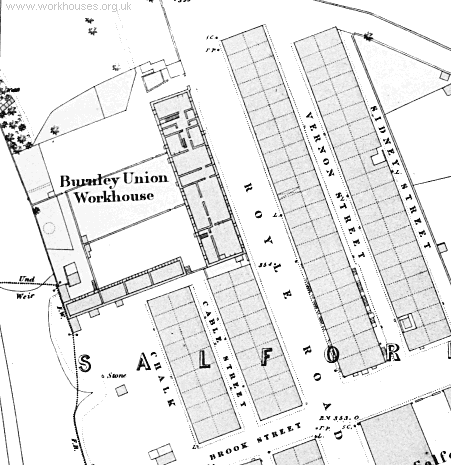
Burnley Royle Road site, 1848.
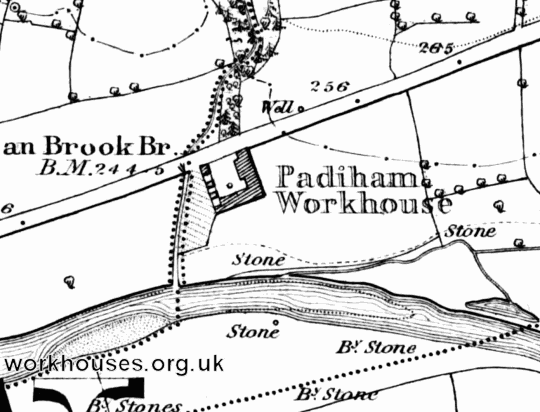
Burnley Padiham site, 1848.
The L-shaped Padiham workhouse was later used as farm but in recent years has stood derelict.
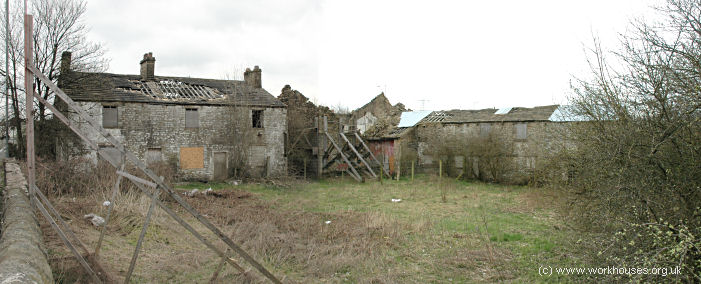
Former Padiham workhouse from the north-west, 2006.
© Peter Higginbotham.
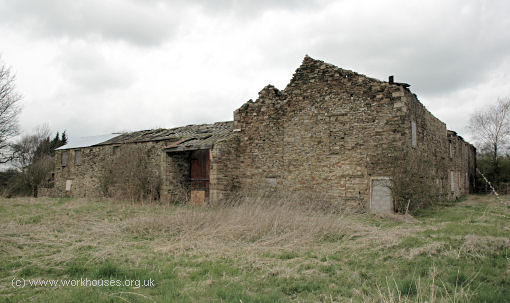
Former Padiham workhouse from the south-east, 2006.
© Peter Higginbotham.
Briercliffe Road Workhouse
Because of the inadequacies of the existing workhouse accommodation, a new workhouse for 500 inmates was erected at a 10-acre site on Briercliffe Road in Burnley. The foundation stone was laid in 1873 and the first inmates admitted in March, 1876. The buildings, which cost about £20,000, were designed by William Waddington of Burnley and the building contractors were Messrs Heap of Burnley. The site location and layout are shown on the 1912 map below.
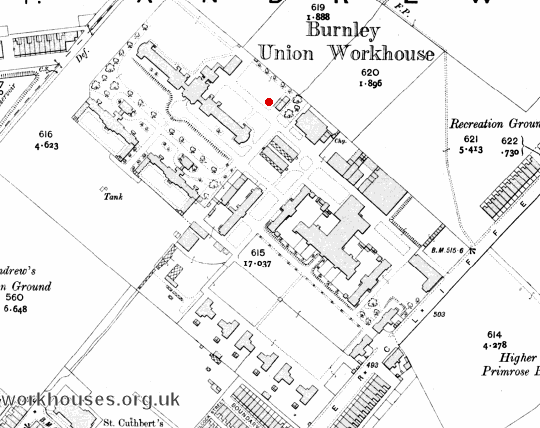
Burnley site map, 1912.
The buildings were constructed in the then popular Italianate style with stone from the Tubber Hill and Burnley Lane quarries. The entrance to the site at the south-east was flanked by single storey entrance blocks, now demolished, containing the porter's lodge and receiving wards.
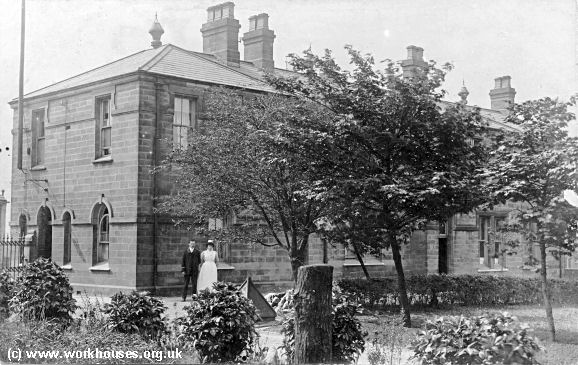
Burnley entrance block, c.1906.
© Peter Higginbotham.
An enlargement of the picture above shows the workhouse porter and nurse.
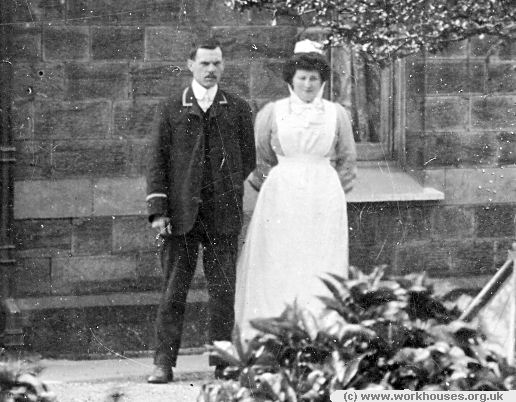
Burnley workhouse porter and nurse, c.1906.
© Peter Higginbotham.
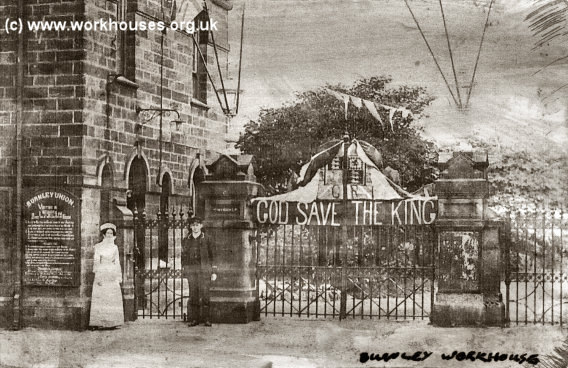
Burnley workhouse entrance, 1911.
© Peter Higginbotham.
The main building was three storeys high with the typical T-shaped layout of the period. Administrative offices were located at the centre, surmounted by a 70-foot high tower. On the ground floor were the Guardians' boardroom, master's offices, and a store for the inmates' own clothes. The Master's and Matron's bedrooms lay above on the first floor.
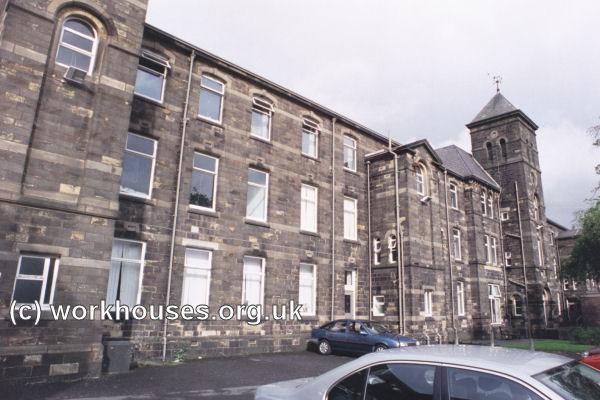
Burnley main block from the west, 2001.
© Peter Higginbotham.
Males were accommodated in the west wing, women in the east. A central corridor ran along each wing with rooms off each side. Day-rooms were placed on the ground floor with those for the aged and imbeciles facing to the front, and for able bodied and children to the rear. To enable segregation of the different classes of inmate, each wing had four staircases located in projections from the building. The corridors were also barred with iron gates.
The centre rear of the main block contained the dining-hall cum chapel.
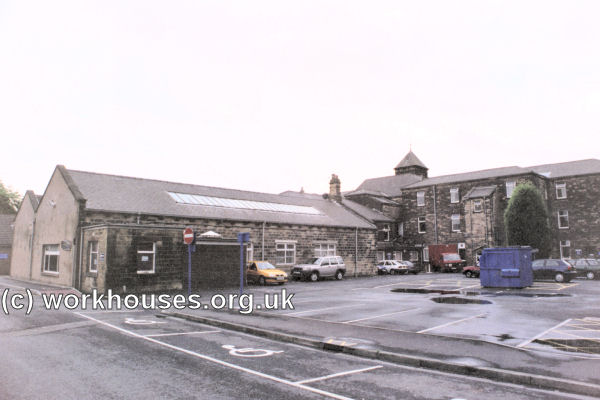
Burnley chapel/dining-hall and rear of main block from the north, 2001.
© Peter Higginbotham.
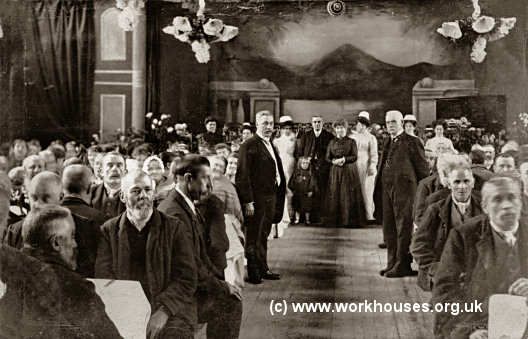
Burnley workhouse inmates, c.1909.
© Peter Higginbotham.
The original workhouse infirmary was a two-storey building immediately to the west of the main block. It adopted an inline pavilion layout with nurses' rooms and kitchens at the centre, and ward wings to each side.
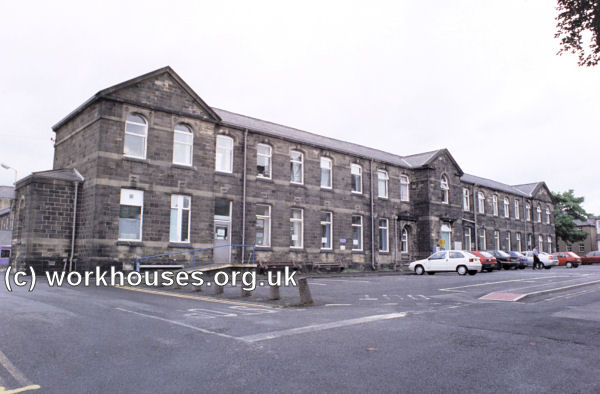
Burnley original infirmary from the south, 2001.
© Peter Higginbotham.
Additions in the 1880s included new wash-houses, workshops, a vagrants' block, and cottage homes for children (see below).
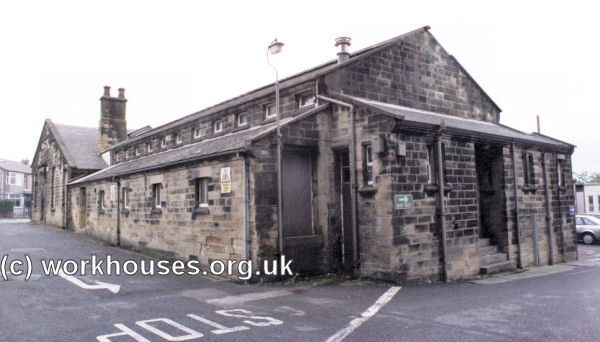
Burnley 1885 vagrants' block from the north, 2001.
© Peter Higginbotham.
A large new infirmary was opened in 1895 to the north of the existing infirmary. It was designed by local architect Samuel Keighley and its construction cost £28,000. It had a central administrative block connected by short corridors to the men's and women's wings at each side.
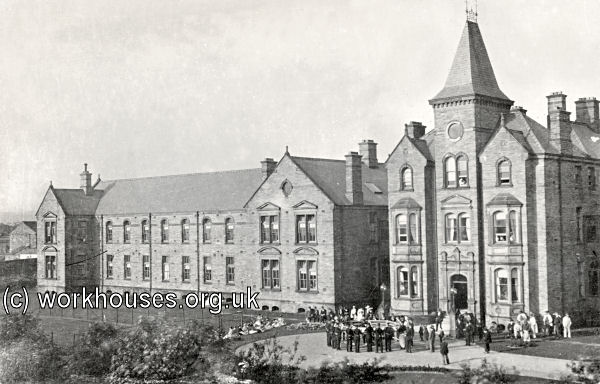
Burnley 1895 infirmary from the south-west, early 1900s.
© Peter Higginbotham.
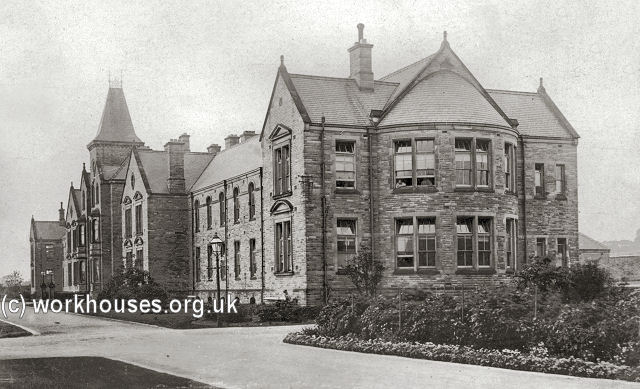
Burnley 1895 infirmary from the south, early 1900s.
© Peter Higginbotham.
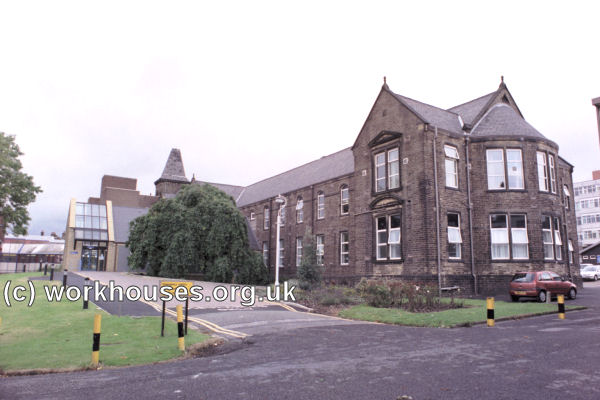
Burnley 1895 infirmary from the south, 2001.
© Peter Higginbotham.
Imbecile wards were erected in 1898-1902 at the west of the site, each holding up to 140 inmates.
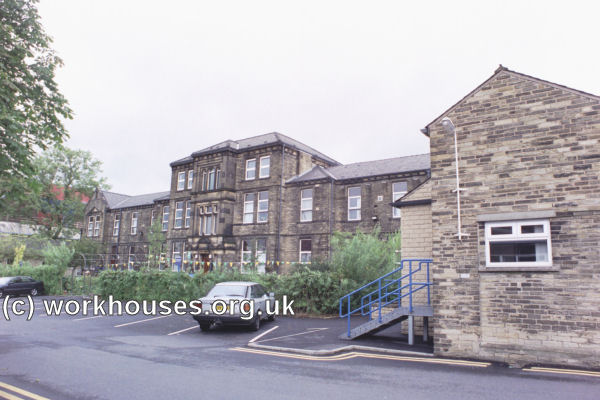
Burnley imbecile ward from the south, 2001.
© Peter Higginbotham.
In 1900-01, new accommodation blocks were erected at each side of the main building, one for 100 males, the other for 100 females.
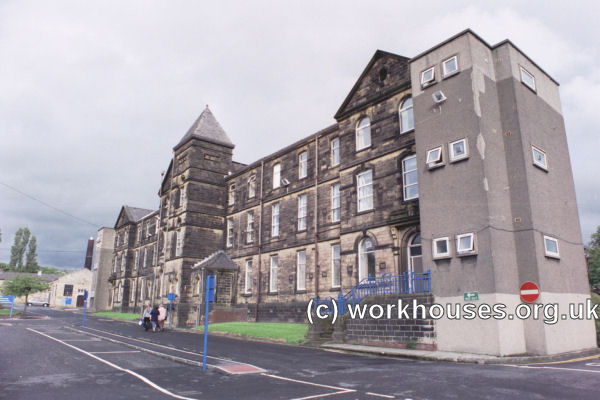
Burnley 1901 northern accommodation block from the west, 2001.
© Peter Higginbotham.
The northern accommodation wing can be seen in the background of the picture below which was taken, facing southwards. from where the red dot is marked on the above map.
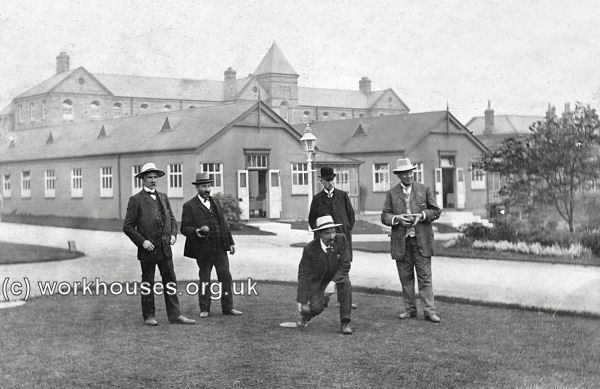
Burnley workhouse, early 1900s.
© Peter Higginbotham.
From 1904, to protect them from disadvantage in later life, the birth certificates for those born in the workhouse gave its address just as 118 Briercliffe Road, Burnley.
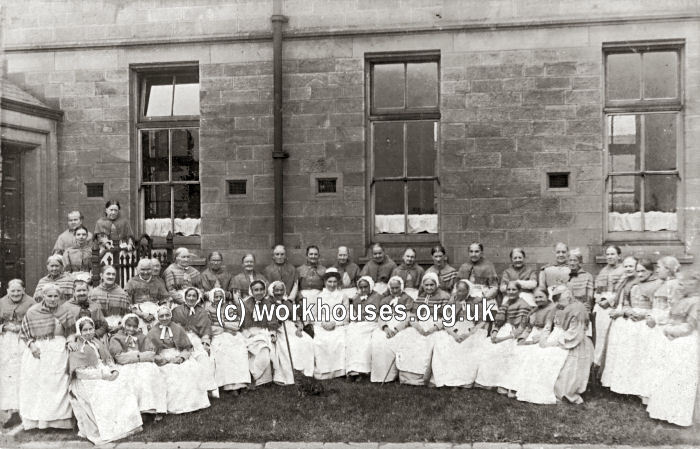
Burnley workhouse inmates, early 1900s.
© Peter Higginbotham.
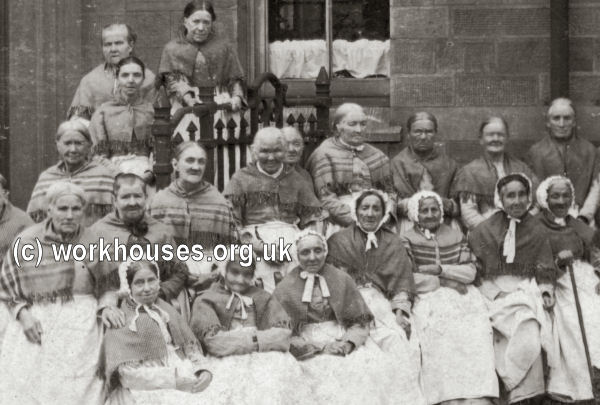
Burnley workhouse inmates (detail), early 1900s.
© Peter Higginbotham.
After 1930, the running of the workhouse was handed over to the Burnley Corporation Public Assistance Committee and became Primrose Bank Public Assistance Institution. The infirmary was taken over by the separate Public Health Committee and was renamed Primrose Bank Hospital.
Following the inauguration of the National Health Service in 1948, the two parts were reunited and became Burnley General Hospital. The main workhouse buildings were demolished in 2008 although a few of the older blocks are understood to still survive, such as one wing of the 1895 infirmary.
Cottage Homes
In around 1890, six cottage homes for children were erected at the south of the workhouse. Each of the homes housed around sixteen children under the care of a house-mother.
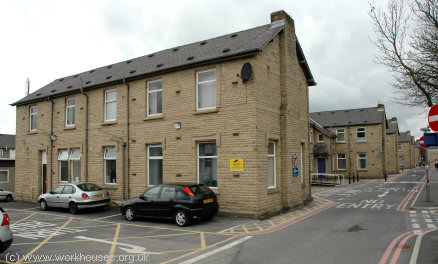
Burnley cottage home from the east, 2001.
© Peter Higginbotham.
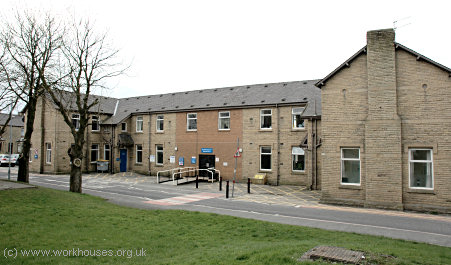
Burnley cottage home from the north, 2001.
© Peter Higginbotham.
Staff
Inmates
Records
Note: many repositories impose a closure period of up to 100 years for records identifying individuals. Before travelling a long distance, always check that the records you want to consult will be available.
- Lancashire Record Office, Bow Lane, Preston, Lancashire, PR1 2RE. Holdings include Union constitution (1836); Guardians' minutes (1837-1930); Creed register (1906-1930); Index to admissions and discharge books (1906-30); Admissions and discharges register (1925-42); Register of inmates' relatives (males 1876-1901, females 1879-1908); Primrose Bank creed registers (1894-1943); Boys' Home admissions/discharges (1925-42); Boys' Home inmates (1925-40); etc.
Bibliography
- Smith, Beryl M (1982) Burnley Workhouse, 1819-1930 (unpublished manuscript).
Links
- None.
Unless otherwise indicated, this page () is copyright Peter Higginbotham. Contents may not be reproduced without permission.


